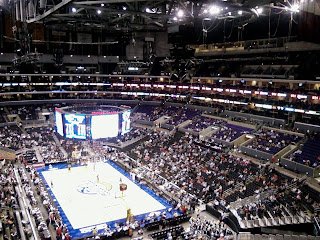FDO, Shapefiles and ArcGIS
 My daughter’s high school basketball team had the opportunity to play at the Staples Center this week in Los Angeles for their first pre-season basketball game of the year. It was a great experience for the girls. Our point guard even buried an NBA length three-pointer during the game! Our opponents were a team from Lancaster that we will play twice more during the year. Although the court was the same size as some of the college venues we play at, the seating capacity was a lot larger. The additional markings on the floor, the wide key and distant 3 point line, also told the story of how others who play on this court are playing at a much higher level.
My daughter’s high school basketball team had the opportunity to play at the Staples Center this week in Los Angeles for their first pre-season basketball game of the year. It was a great experience for the girls. Our point guard even buried an NBA length three-pointer during the game! Our opponents were a team from Lancaster that we will play twice more during the year. Although the court was the same size as some of the college venues we play at, the seating capacity was a lot larger. The additional markings on the floor, the wide key and distant 3 point line, also told the story of how others who play on this court are playing at a much higher level.For existing Autodesk Map 3D users the ability to read and write Shapefiles is a useful feature, likewise the access to simple feature layers stored in ArcSDE using FDO. You can even add to that working with WMS map services served up by ArcGIS Server that are similar to the Map Service capability of ArcGIS for AutoCAD, but without the ability to identify features.
If you use Civil 3D the included Autodesk Map 3D functionality gives you access to Shapefiles and ArcSDE simple features you can use in the process of design.
If the main reason I use Autodesk Map 3D is to read and write Shapefiles to work with ArcGIS than I'd say there is an easier way. ArcGIS for AutoCAD working with plain AutoCAD files is superior to using tools that read and write Shapefiles, simply because the support in ArcGIS of the resultant AutoCAD files is better. Namely the attributed feature classes inside AutoCAD files that are created and read by ArcGIS for AutoCAD and ArcGIS desktop are self-contained in the AutoCAD file and can include curves and annotation. The simple features in Shapefiles don’t support annotation or curves. Software that reads and writes Shapefiles in AutoCAD adds another level of cost and complexity; ArcGIS for AutoCAD is free and works on pure AutoCAD entities within a single AutoCAD file. But if I have Civil 3D it’s not a bad way to go.
When considering the Autodesk Map 3D FDO connector for editing however, I must be concerned not only about the lack of curve and annotation support, but also in the fact that the GIS data in ArcSDE may be participating in a geodatabase, for which the ArcSDE API used by FDO has no awareness. The blind simple features edits of FDO made directly to ArcSDE can and will ignore important data integrity rules established in a geodatabase, so be careful.
The girls are now 1-0 in the pre-season.


2 Comments:
Hi there Don!
I'm currently a 5th year student working on my Master degree in GIS, more specifically in the field of geodatabase design for water networks on our campus. We are three students each working on a different network, water, electric ane network cables respectively.
We are really in need of some scientific articles or journals abour our study. We are mainly looking for information on how prvious problems in our field have been solved. We need to build our own gdb. from scratch with all the correct data, topology, relationship classes, geometric networks etc. for the three different networks on our campus - in short, we need to develop a central gdb. with all the network data for the management of our campus.
We would appreciate your inputs so much!!!
Regards,
Armand du Toit
Armand,
I'd be interested to learn more about what you are doing. Go ahead and contact me directly... dkuehne@esri.com
Post a Comment
<< Home